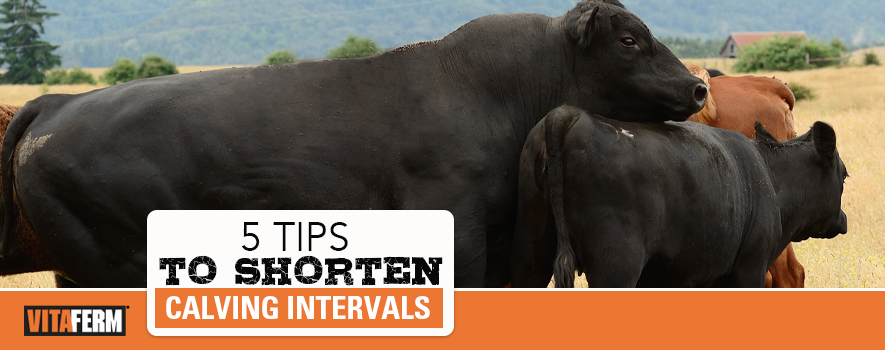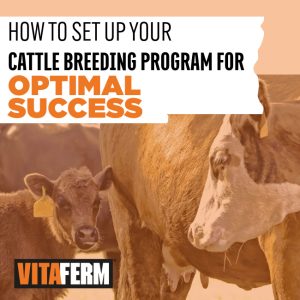Optimum productivity should be the goal of each cow-calf producer, and that productivity begins with cows producing at least one calf every year. With proper management, good health protocols and a quality nutrition program, that goal is easily attainable.
Shortened calving intervals – or the time between the birth of one calf and the subsequent birth of the next from the same cow – are beneficial to both the productivity and profitability of the herd. In addition, from a labor efficiency standpoint, it just makes sense to calve over a 60-day window as opposed to 120 or 150 days, causing twice the length of sleepless nights, stress and labor resources.
Let’s explore five tips to shorten the calving intervals and increase the profit potential that producers can add to the herd when the calving windows are shortened.
1. Start with a good nutrition program.
A cow’s nutrient requirements are at their highest around re-breeding time. Not only is she trying to maintain her own body condition while in peak lactation to provide nourishment to a rapidly growing calf, but she’s simultaneously trying to heal her reproductive tract in order to support and maintain a new pregnancy for the coming year. That is why it is absolutely pivotal to make sure she is getting the required amounts of vitamins, minerals, energy and protein to support adequate performance. In addition to these essential nutrients, Phosphorus and Vitamin E will help encourage repair of the reproductive tract and help her get ready to come into heat and breed back sooner.
A product like VitaFerm® Concept•Aid® is specifically designed for reproductive success when fed 60 days pre-calving through 60 days post-breeding. Concept•Aid is especially beneficial in A.I. and E.T. breeding programs. It contains organic copper, zinc and manganese to ensure maximum bioavailability of nutrients to the animal, and also contains high levels of Vitamin E and Selenium to promote optimized fertility. Like all VitaFerm products, it contains Amaferm®, a prebiotic designed to enhance digestibility by amplifying the nutrient supply within for maximum performance. Amaferm is research-proven to increase milk production and initiate and maintain pregnancy and fertility.
2. Use heat synchronization protocols.
With the ever-advancing technology that is available for cattle producers, getting cows to come into heat at the same time, and more rapidly is easier than ever before. Technology like CIDR devices and timed A.I., can help tighten the calving window and get cows to come into heat sooner, resulting in a shorter calving window.
3. Make sure your bulls are reproductively sound.
If you are turning your cows out for breeding naturally, it is pertinent that you make sure your bulls have a breeding soundness exam (BSE) 30-60 days before turnout, and that they are semen tested. If they are not fertile, not only will you have a lot of open cows, your calving interval just got a lot longer when all of your females come into heat again for a second or third time before you realize the problem. The longer it takes to get the collective group bred, the longer your calving season will be.
4. Be disciplined and be aggressive.
Be sure to mark your calendar, and when your breeding season is up, whether that is 60 days or 90 days, pull your bulls. And then, 30-45 days later, have your vet come and preg-check everything that has been exposed, either naturally or via A.I. By sticking to your schedule, not only will you save some labor for your bulls to preserve them for the next breeding season, but it will also help you determine which cows are the most reproductively sound and fastest to breed back.
5. Cull problem cows.
It is never fun to cull cows from the herd, but after you preg-check is when it is most important to be aggressive and make your culling decisions. Perhaps you have a cow with great genetics that had some calving difficulty or another challenge that came up open. You must decide if it worth keeping her open for another calving season to see if she will heal and breed back or if it is time to sell her and replace her with new genetics. If a cow continues to have issues with getting and remaining bred, you just can’t afford to keep an open cow.
Not only does the shortened calving interval benefit your cow herd and labor management at calving time, its primary benefit to the producer is at weaning or when it comes time to market the calf crop. Calves that are born in a tighter window will be more uniform in size and weight and will be more ideal for load lots, which often receive a premium when buyers don’t have to gather up small groups of calves from multiple sellers. Groups that are more uniform in size won’t have a “pecking order” where smaller calves are pushed away from the bunks, therefore hurting their gain and performance.
Consider this example. If a calf typically gains 2-3 pounds per day, it will gain an additional 52.5 pounds per 21-day breeding cycle. That means, if you shorten your calving window to 60-days, calves born in that first cycle will weigh 105 pounds more at weaning than calves born in the last cycle. Calves at weaning average $1.50 per pound, so you have already increased your profits by $157.50 per calf from that first calving window vs. those in the last group.
In addition to added profit at weaning, producers will realize other cost saving benefits to shortened calving intervals. Strategic herd management means an increased concentration of labor, where animal husbandry is more focused on similar stages of production at the same times and for shorter times, such as breeding, calving, calf care, and the labor efforts for these duties are not spread out over long periods of time.
A growing calf every 365 days is NOT a lofty goal. With good management practices, and sound nutrition and health program and less stress for the producer, you can have tighter calving intervals, producing those calves on a more regular basis, and seeing more profit in your pocket each and every calving season.



